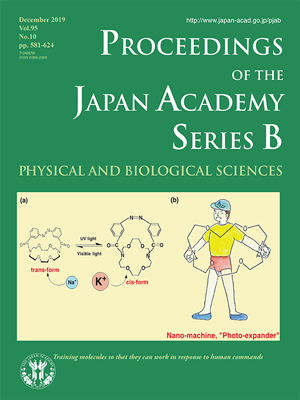About the Cover
Vol. 95 No. 10 (2019)
It is frequently said that “even a human being consists of molecules,” but it is scarcely explained how molecules assemble and function to form a human being. When Professor Seiji Shinkai was studying chemistry as a student of Kyushu University, he envisaged that molecules eventually form a living body when they are equipped with a variety of dynamic functions and assembled according to a specific program. On such a student, an American movie (produced in 1966) titled “Fantastic Voyage” (Japanese title: Desperate Adventure to the Microscopic World) exerted a strong influence. In this movie, shrunken medical doctors enter a patient’s body and cure a diseased organ. Consequently, he started his carrier by challenging in this attractive research field by development of strategies for controlling the molecular motion and the relevant function by a human-controllable command but not by the conventional thermal Brownian motion. Compound (a) shown in the cover page is the first example of such a molecule that can change the structure in response to UV/visible light using a trigger received from the outside world. This was termed a “photoresponsive crown ether”. In response to the light-mediated cis–trans interconversion of the azobenzene cap, the metal-binding selectivity can be modulated between Na+ (higher affinity with transform) and K+ (higher affinity with cis-form). Cartoon (b) is an image of a nanosized dwarf expanding the crown ether ring with the aid of light energy. Now, this molecule is recognized in the scientific world as the first artificial “molecular machine,” which was designed and synthesized in 1979. Thus far, his research has not only developed new macrocyclic host molecules for “static” molecule recognition but also involved “dynamic” recognition, which has produced many functionalized host molecules. At present, this idea has been widely accepted as a general principle used to design “molecular machines” that consist of the following sequence of events: stimuli input --› receipt by antennae --› change in their dynamics/structure leading to work/function of the molecular systems. Furthermore, his group has extended this dynamic concept to molecular assembly, emergent, and even gene delivery systems. This review (pp. 590-601) concisely describes his challenging and attractive voyage, which has greatly contributed to topics ranging from the real origin to the progress in the construction of artificial molecular machines. I believe that these systems bearing dynamic molecular recognition capability or controllable stimuli-responsive ability developed by his research group can be broadly applied to many systems and interfaces with biological systems as well as for industrial purposes. It now turned out that the long voyage of Shinkai’s group was not desperate but remarkably fruitful to generate a new research field that is the artificial molecular machine.
Itaru Hamachi
Professor and ERATO Research Director, Graduate School of Kyoto University




